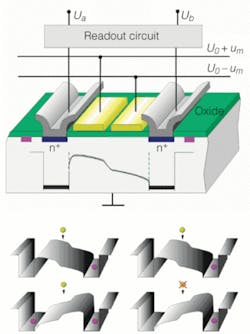Video range camera provides 3-D data
Andrew Wilson, Editor, [email protected]
In a presentation at this year’s European Machine Vision Association conference, held in Tampere, Finland, Robert Lange of PMD Technologies (Siegen, Germany; www.pmdtec.com) described the design, development, and possible future applications of the company’s latest three-dimensional (3-D) range camera, the Vision 3k-S 3D. The camera is based on the time-of-flight principle and a 64 × 48-pixel photonic-mixer-device (PMD) sensor array developed by the company.
Distance data are acquired by modulating the scene with modulated near-infrared light. Each pixel simultaneously delivers distance information, distance resolution, and gray-scale information.
Moving the charge
These smart pixels use two photo sites to obtain 3-D data (see figure on p. 20). The gates (shown in yellow) are connected to circuitry that reads charge accumulated at each photo site. In a PMD pixel, the movement of generated charge is controlled by modulating the incident light that falls on the two photo sites. By doing so, charge can be transported to left or right gates.
If, for example, the incident light is constant and modulation is consistent across both gates, generated charge will move to the left and right equally. At the end of the cycle, the output voltages at each readout node will be the same. If, however, the incident light is modulated and there is no phase delay between the modulation of light used to illuminate the scene and the photoarray, then charge will move to one of the readout diodes.
For other phase delays, the modulation of the light and its phase delay will result in a difference between the two output voltages. Because the difference of both output nodes is directly dependent on the phase delay between light and pixel modulation, this difference can be used to calculate the distance from a light reflecting object to the sensor.
One of the key features of the camera is the active suppression of background illumination (SBI) for each pixel. To improve the dynamic range of the PMD device, additional circuitry is used for SBI. This circuitry removes the charge packets of background illumination and dark current from the readout nodes, which allows precise 3-D measurements even in bright sunlight. This is a key feature for automotive imaging systems that may have to operate in sunlight that may be up 10,000 times brighter than the active illumination of the 3-D camera.
In the design of the Vision 1k-S 3D camera, an AMD Elan SC520 32-bit processor running the eLinOS operating system controls camera functions. Timing for the 64 × 48 PMD is implemented in an FPGA. Once images are captured, distance information can be calculated within the camera and 3-D data can be transferred to a PC.

